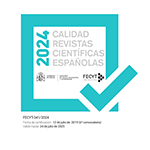Consideraciones sobre la lengua de las rimas políticas del Canzoniere de Petrarca
Abstract
Maurizio Vitale concludes his amazing, and relatively recent essay La lingua del «Canzoniere» di Francesco Petrarca (1996) stating that if Dante’s Commedia is the fundamental linchpin of written and spoken Italian language, the Canzoniere has been, throughout the history of linguistics, the model for literary Italian. In this work by Petrarch the use of language includes an evocative mixture of different stylistic features, even if diluted in a seeming uniformity. This is due to the strong literariness permeating all levels: from the phono morphological one to the syntactic or lexical one. In particular, it is the small sub-thematic group of works about the political dispute, to show the most realistic register of Petrarch’s language, in sharp contrast with the general strain of the Rerum vulgarium fragmenta. These works are: the Sonnet 27 and the Canzone 28, written on the occasion of the crusade of 1333; the Can - zone Spirito gentil and Italia mia, and three sonnets, 136 138, written against the papal court in Avignon.Downloads
Article download
License
In order to support the global exchange of knowledge, the journal Cuadernos de Filología Italiana is allowing unrestricted access to its content as from its publication in this electronic edition, and as such it is an open-access journal. The originals published in this journal are the property of the Complutense University of Madrid and any reproduction thereof in full or in part must cite the source. All content is distributed under a Creative Commons Attribution 4.0 use and distribution licence (CC BY 4.0). This circumstance must be expressly stated in these terms where necessary. You can view the summary and the complete legal text of the licence.










